Table of Contents
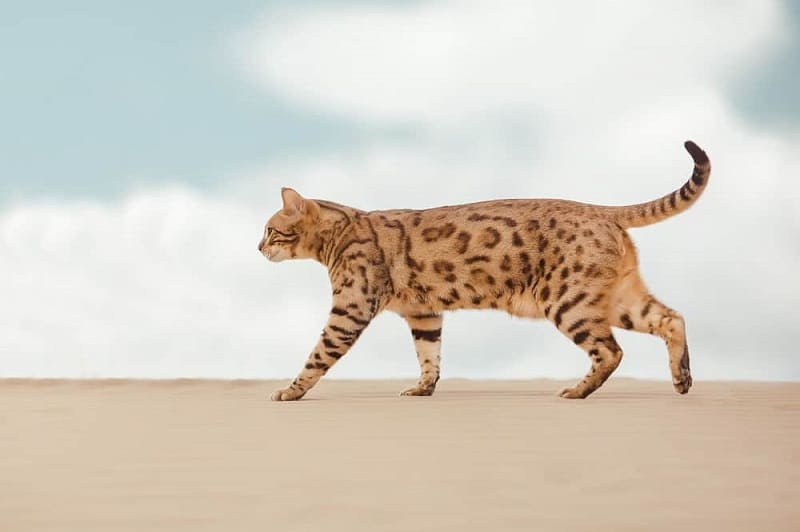
Savannah cats made their first appearance in the 1980s, and were bred to look like spotted wild cats, even though they are meant to be house pets. They have the appearance of a cheetah, with coats that have black spots, huge ears, and extremely long legs.
When it comes to the size of a Savannah cat, they are obviously much larger than a typical house cat. In fact, their legs are so long that since 2006, they have held the Guinness record for being the world’s tallest domestic cat. So, what is a Savannah cat? The Savannah cat is a domestic breed that can be distinguished by their large, dark eyes that are highlighted by dark tear marks. They also have vibrant coats.
Where Do Savannah Cats Come From?
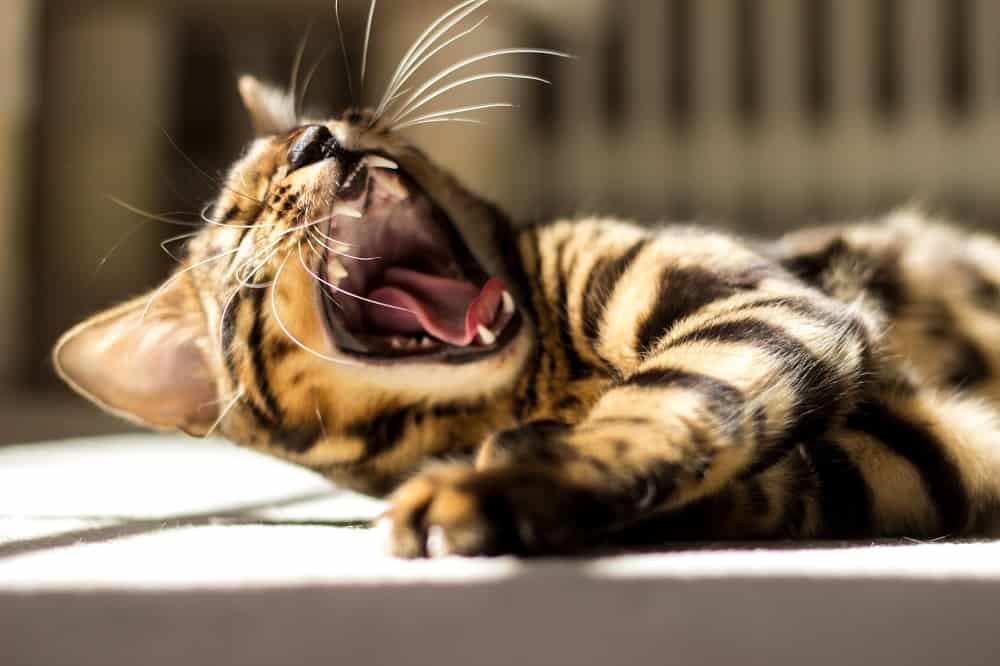
There is no actual place that these cats are from. In fact, the very first Savannah cat was the result of an unplanned pairing in the early 1980’s by a breeder of Bengal cats in the United States. In the 1990s, the first Savannah cats were bred. The first of these cats was what is known as an F1 Savannah cat, and although it may have been a mistake, it was the beginning of something very beautiful and unique.
What Does the Name Savannah Mean?
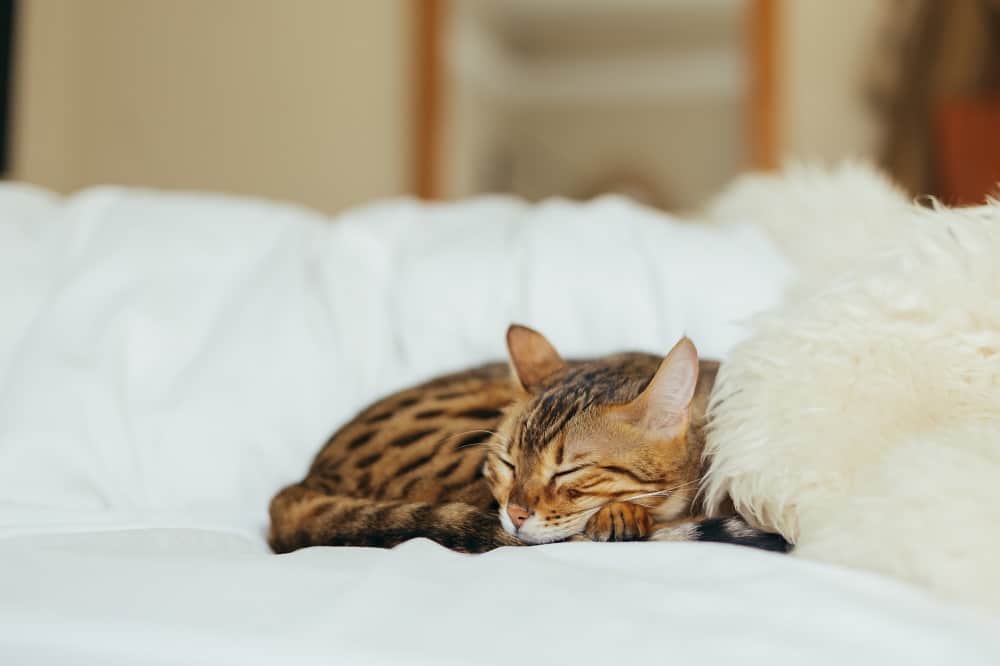
A lot of people think that Savannah cats are named for a specific geographical location. Actually, the origin of the name is much simpler than many would realize. The very first of these cats was, as noted in the previous paragraph, a first generation or F1 female, and her name was, “Savannah.” The breeder used this name as the name of the entire breed.
This first Savannah cat could have been named for the area that its ancestor hails from. The Savannah cat is a distant relative of the African Serval cat. This particular cat hails from the East African Savannahs, so it is likely that the first breeder of these cats chose this name for the first female, and for the breed itself.
Are Savannah Cats Hypoallergenic?
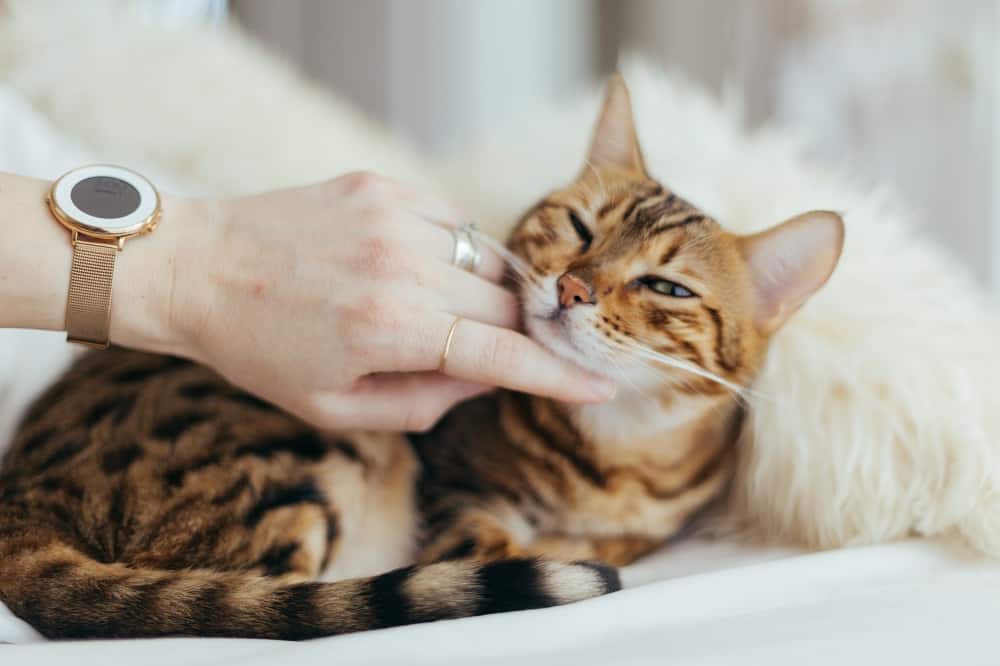
If you are looking for a pet that is hypoallergenic, the Savannah cat is not it. While it is rumored that they are hypoallergenic pets, there are in fact no cat breeds that are truly hypoallergenic. Then again, hypoallergenic doesn’t mean that something does not cause allergic reactions at all. It simply means that there may have few or possibly no allergens. There is no guarantee that someone will not experience an allergic reaction to a Savannah cat, or to any other type of cat, even if the breeder says that it is hypoallergenic.
But, there are some cats that have fewer allergens than others, and that those who have pet allergies are better able to tolerate. If you would like to have a cat and there are others in your home who have allergies to cat hair, dander, etc., then you may want to consider getting a Savannah cat. The reason why Savannah cats are often better for those who have allergies is because they have shorter coats than many other beautiful and magnificent cat breeds. Most reputable breeders will not try to tell you that they are selling hypoallergenic animals, because they know this to not be the case.
Serval vs Savannah Cat
Serval cats and Savannah cats are two distinctly separate breeds, although the Savannah cat is a cross between a serval and a domestic cat.
Understand the difference of the two breeds, serval vs savannah cat, on the short video below:
These two types of cats look very much alike, but there is one significant difference, and that is that serval cats are wild, and Savannah cats are domesticated.
First, let’s answer the most important question: What is a serval cat?
A serval cat is a cat that some people have domesticated, but it is still considered to be a wild animal. This is a cat that is native to the African grasslands south of the Sahara. It has the longest legs and largest ears of any of its feline relatives. Serval cats, according to the San Diego zoo, are considered to be endangered species.
Historically, serval cats have been well documented. The serval was a symbol for the Tomasi family of Italy. It was also worshipped by the ancient Egyptians for its power, grace, and agility. Owning one of these cats can be extremely risky, because as already stated, they are wild animals. They are not meant to be house pets.
Savannah cats, on the other hand, make ideal house pets, because they were bred for that reason. Yes, they are a cross between the serval and a domestic cat, but they do not have the wild traits of the serval cat. For one thing, they can easily be trained to use a litter box, just like any other house cat. Serval cats, on the other hand, aren’t so easy to train. Even those that are trained will still do their business in other areas besides their litter boxes.
A Savannah cat can easily adapt to many situations, whereas serval cats do not like change. Oddly enough, Savannah cats are much more independent than serval cats, and do not need as much attention. But, they are friendly and loving, and are a much better option if you are looking for a house pet.
Buying a Savannah Cat
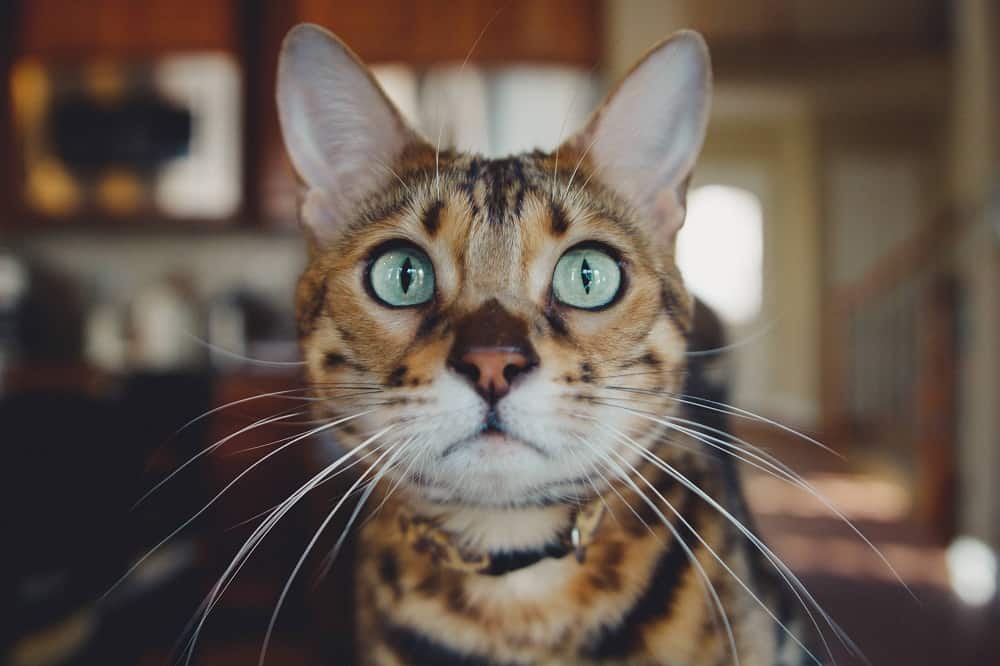
When buying a Savannah cat, there are many questions that you will need to consider, including the cost to buy one of these cats from a breeder. So, the first thing to do is to find a breeder, and you will want to know not only about where to buy a Savannah cat, but also the following:
- How much does a Savannah cat cost?
- How much are Savannah kittens?
You should also think about more than just the Savannah cat price. For instance, how much does it cost to have a cat in general? Consider food, vet care, toys, and other expenses that go along with being a pet owner in addition to the actual cost of a Savannah cat.
So, how much is a Savannah cat? It actually depends on a number of factors, including the coloration and other characteristics of the cat, as well as the breeder. The price of a Savannah cat can range from $1,200 to $22,000, depending on the generation. F1 Savannah cats do not produce often, so their babies are the most desirable, and this is the Savannah cat cost that is the highest.
When buying a Savannah cat, one of the most important things to look for is that they meet the breed standards. If you are going to buy a Savannah cat, the ideal to look for is one that has the wild look of a wild cat, but the docile temperament of a house pet. If you see a Savannah cat for sale that looks more like a Bengal cat, chances are that it comes from a poor bloodline.
Owning a Savannah Cat
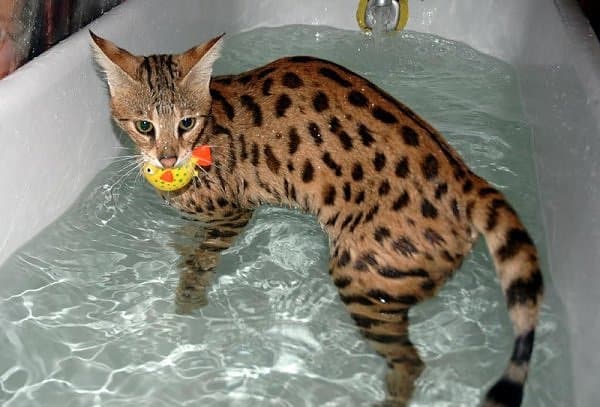
Owning any type of pet is a huge responsibility, and it is no different with a Savannah cat. In fact, due to the simple fact that this is the tallest house cat in the world, you may find yourself with a lot more to do in the way of caring for your Savannah cat.
Obviously, you are going to need to cat-proof your home, and things that you may think are out of reach will have to be put even higher. Remember, this is not your typical small house cat. In fact, it is likely going to be at least two to three times the size of a large house cat, and can weigh as much as 25 pounds.
These cats need medium to high levels of exercise, as they tend to have a lot of energy. Their exercise should include socialization as they are kittens, so make sure that they are exposed to friendly people and animals, and always offer positive reinforcement. They are highly intelligent animals, and naturally curious, so they can get into a lot of mischief. They are best suited with owners who are active and will give them the time and attention they need.
Savannah Cat Characteristics

Now that we have introduced you to the Savannah cat, we are going to go into more detail about these cats, including their characteristics. Let’s start with the colors. Savannah cats can be found in four main color groups:
- Brown
- Silver
- Black
- Smoke
While these are the main colors, any colors that are like those of the African Serval cat are acceptable.
For fast tips about the characteristics and some of the important health considerations of Savannah cats, check the video below:
As for the pattern, you will see dark spots that are round or oval in shape, and solid in color. Ideally, these spots will not be connected. There will also be parallel stripes going from the back of the head to just above the shoulder blades, and they will spread out across the back a bit. Some Savannah cats also have smaller spots on their legs, feet, and even on their faces. They have coats of dense hair that is short and coarse.
Eyes
Now we take a look at the eyes. They should be medium in size, and be deep set with a brow that is somewhat hooded. The shape of the top of the eye is not unlike that of a boomerang, with an angle that brings the corner of the eye down the nose line. The bottom part of the eye is almond-shaped. The eyes sit low on the forehead. They can have any eye color that other cats have, no matter the color of their coats.
Ears
The ears of the Savannah cat should look a lot like the ears of a serval cat. The serval cat has the largest ears of any cat, wild or domesticated, and they are also the largest in relation to their head size. So, because they are related to serval cats, Savannah cats have large ears that sit high on their heads. Their ears are wide, and the base is deep, with rounded tips.
The inside of the base sits near the top of the head, while the outside base should start no lower than the eyes (higher is okay). The inside base of the ears is near the top of the head, and ideally there will be vertical, parallel lines that go from the inner corners of the eyes to the inner ear base. The more pronounced the ocelli ear markings, the better.
Head shape
A Savannah cat’s head should be broad, and look like a wedge that has rounded edges and contours. It should be longer than its width, with a long nose and small chin. If you were looking at the anterior view, the face should show a triangular shape that is very symmetrical. While most spotted cats, as well as tabbies, have the well-known “M” marking between their eyes, it is preferred that Savannah cats have an “11” marking. But, this is not the breed standard; it is just preferred.
Temperament
These cats do need a lot of social interaction, and they will sulk if they are not included in the action. They are very kitten-like, no matter how old they are, and they are very loyal to their people. The Savannah cat temperament can make them wary of strangers, but they do make awesome companions.
Intelligence
Cats are highly intelligent creatures to begin with, and Savannah cats are no exception. They are easy to litter box train, and they can even be trained to understand and obey (sometimes, they are cats after all) commands ranging from simple to complex. They can be leash trained, and it looks pretty cool to see someone walking around town with what looks to be an exotic animal on a leash.
Nutrition
When it comes to nutrition, cats are cats. Savannah cats basically require the same nutrients as any other breed of cat. The biggest difference is that because they are so large, they do require a lot more food than the average house cat. Some are under the misconception that Savannah cats require a raw meat diet. While this is healthy for them (containing the most nutrients), it is not necessary. If you are considering buying a Savannah cat, you might want to talk to your vet about the best type of diet to feed it through all of the stages of its life. Obviously, they require fresh water to be available to them at all times.
Exercise
It is never a good idea to let any pet become overweight, and this is also true of the Savannah cat. While they do look lean and muscular, if they are not given enough opportunities for play and exercise, they can start to become overweight. They need a lot of exercise, and many people actually get them cat wheels so their pets can go for a run whenever they feel like it.
It is important that as kittens, their exercise includes socialization. This way, they do not have as much of a tendency to be wary of strangers later in life. If these cats do not get enough exercise, they tend to become bored, and this is when they start to become mischievous.
Health Issues
Savannah cats are not known to have any specific health issues that are related to the breed. But, it is important that genetic testing is done, to ensure that there are no breed-specific health issues that develop. One common problem is that reproduction and fertility are difficult for Savannah cats, and the cause of their infertility is often genetics. These cats have longer gestation periods than regular cats, making reproduction more difficult.
Other than reproduction issues, this breed is not known to have a lot of health issues. That being said, they can end up with any number of health problems that other cats can have, including the following:
Congenital health issues
All cats are prone to congenital health issues, although many of these issues do not cause any decline in the quality of a cat’s life. These defects can begin in the developmental stages of embryo and fetus, but the causes of many of these defects is not known. One theory is that environmental circumstances when a cat is pregnant can come into play here. Some of the most common congenital health issues include:
- Cleft palate
- Extra toes (polydactylism)
- Dwarfism
- Extra vertebrae
- Liver shunt
- Hydrocephalus
Non-congenital Health Issues
There are also non-congenital health issues that can be common to all breeds of cats, and these are not caused by genetics. In most cases, these health issues can include bacterial, viral and fungal infections.
Bacterial infections
- Urinary tract infection
- Coccidia
- G-strep
- Giardia
- Campylobacteriosis
Viral infections
Upper respiratory infection (URI)
Fungal infections
Ringworm
If you think that your Savannah cat, or any of your pets is sick and that it may be any of these conditions mentioned here, it is important to contact your vet so they can diagnose and treat the problem before it becomes too serious.
Other Health Issues
In addition to congenital and non-congenital health issues, there are many other problems that can plague your kitties, including Savannah cats.
Diarrhea
Diarrhea is a condition that can be caused by numerous things, and it is not uncommon to see it in Savannah cats and all other types of cats. Often, it can be caused simply by making a change to your cat’s diet. A bit of diarrhea is nothing to be alarmed about. But, if you notice excessive diarrhea, lethargy, dehydration, blood in the stool, fever, vomiting, and other symptoms, contact your vet for immediate treatment as it could be a sign that something more serious is going on.
Parasites
Tritrichomonas
This is shed in the feces, and adult cats can be carriers, even if they are not showing signs. Symptoms include loose stool, smelly stool, blood or mucus in the stool, or difficult passing stool.
Giardia
This happens when a cat swallows a parasite in the cyst stage. It is highly infectious, and can be transmitted by sniffing cysts from contaminated ground. Symptoms may not appear for several years.
Roundworm
These are the most common parasite found in cats, and extremely common in kittens. They live in the cat’s intestine, and the eggs are passed into the feces, where they can take many days to many weeks to develop into the larval stage, which is infectious.
Hookworms
These slim worms attach themselves to the intestine’s wall lining. They feed on their host’s blood, and are often undetected because they are so tiny. They can live as long as your cat.
Coccidia
This one-celled organism is microscopic, and pretty much all cats become infected with it at some point. They can get this by eating a cyst, or by eating flies and other insects, including cockroaches.
Any cat, including a Savanna cat that has any of these parasites should be treated by a veterinarian.
About the Breed
Savannah cats are among the most beautiful cats in the world. As we mentioned, this breed started as an accident, but was so beautiful that it was eventually created as its own specific breed. There are a variety of colorations and patterns on Savannah cats, and they are nearly as large as their African ancestors, the serval cats. Savannah cats are easy to train, and make terrific house pets. If you want a Savannah house cat, you will be in for an adventure.
While most Savanna cats have very visible spots, there are also black Savannah cats. This Savannah cat breed has color patterns that are similar to black panthers, black with darker black spots, as well as rings on their tails. They always have black noses, and this is a color pattern that is acceptable by TICA standards. These cats can be officially shown, and many are among the most beautiful show-quality cats, shown by many Savannah cat breeders.
Some people think that there is also a variety called the African Savannah cat. Actually, the since the Savannah cat is derived from an African cat, this is why the name is used. There is no actual Savannah cat that is from Africa.
When comparing a Savannah cat to a Bengal cat, you might find that they look a lot alike, but that they have very distinct differences. For instance, Savannah cats are much larger than Bengal cats, which weigh in at around 16 pounds or so. Bengal cats also have an appearance that is very different from that of Savannah cats, including what looks like a sprinkling of gold or silver dust on their coats. While Savannah cats are friendly, Bengal cats are going to be more likely to be snugglers.
Now, let’s look at the Savannah cat compared to a regular cat. Obviously, the first major difference you are going to notice is the size. Most house cats typically weigh about 8-12 pounds, while a Savannah cat can grow to be up to 30 pounds. Cat-proofing your home is going to be a lot different for a Savannah cat than a regular house cat, because of their size. They are able to get into a lot more areas, and can cause a lot more damage. They also cost a lot more to care for, at least when it comes to feeding and filling the litter pan.
Savannah Cat Generations
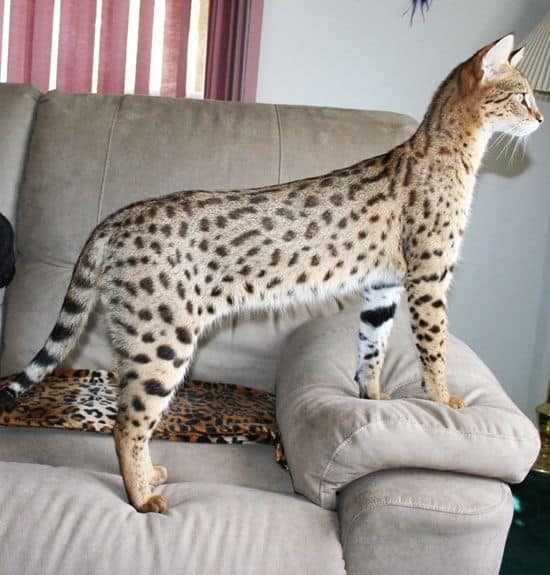
Here is the most confusing thing about Savannah cats: understanding the generations, which are F1 to F6. Let’s take a look at what the various letters and numbers mean.
“F” stands for Filial generation, which is how many generations removed a cat is from its original ancestry. For instance, an F1 Savannah cat would be a first generation offspring, with a Serval parent (usually the father) and a domestic cat, so you should know this if you see an F1 Savanna cat for sale.
An F1 Savannah price is going to be the most expensive, often more than $20,000, because when it comes to Savannah cats, F1 is the most desirable. A Savannah F1 cat comes from that very first one created, so the Savannah cats F1 price is always higher. The price does not have anything to do with the F1 Savannah cat size.
But to speak in general, Savannah cats are usually expensive and considered to be a rare breed of cat.
An F2 Savannah cat is a second generation offspring, and has a Serval grandparent. It is the closest to an F1, so the F2 Savannah cat price is likely to be high, upwards of $10,000. Again, this has nothing to do with the F2 Savannah cat size. There is little difference between the two generations, with the exception that one is a first generation.
An F3 Savannah cat is a third generation offspring. This means that one of its grandparents was a serval cat. The F3 Savannah cat price is going to be lower than an F2, and the F3 Savannah cat size is going to be slightly smaller than an F1 or F2.
An F4 Savannah cat size is that of the others, but it is farther removed from its African ancestor, with a great grandparent being a serval cat. The F4 Savannah cat price is going to be much lower than that of an F1, and a Savannah cat F4 is still a quality animal. Next we have an F5 Savannah cat. You can see that he prices are coming down, and that the F5 Savannah cat price is even lower than the F4 cat.
Finally we have the F6 Savannah cat. When it comes to cost, the F6 Savannah cat price is going to be the least expensive, and it is even cheaper when compared to an F5 Savannah cat. The F6 Savannah cat size is a bit smaller again. When comparing a Savannah cat F1 vs F5, the biggest difference is the price, followed by the size.
Once you have figured out what the various generations mean, there are other letters that show the generations of Savannah to Savannah breeding. For instance, the letter A represents a cat with one parent that is a Savannah cat, and the other is an outcross. The letter B means that both parents are Savannah’s, one parent is an A, and at least one grandparent from either side is an outcross. The letter C means that both parents are B or above, and at least one of the parents is a B, and one grandparent is an A.
Then, there is SBT, which means Stud Book tradition. This kitten has three generations of Savannah parents, and is considered to be the purest breed of Savannah cat.
Which Generation Should You Choose?
When buying a Savannah cat, does it really matter which generation you choose? Well, it all depends on whether you are looking for a house pet or a show cat. Obviously, an F1 or F2 Savannah cat is going to be the best as a show cat, but they can still be pretty lovable pets.
On the other hand, if you are simply looking for a pet, you may not wish to spend upwards of $20,000 on a cat. So, before choosing a Savannah cat, think long and hard about your reasons, and then decide just how much you are willing to spend. Remember, an F6 Savannah cat is no different from an F1 when it comes to having a loving pet.
Conclusion
If you really want to own an exotic animal, which in most parts of the US is illegal or at least very seriously restricted, your best option is to get a Savannah cat, of any generation. These large cats have the look of a wild animal, but the temperament of a house cat. They can easily be trained to use a litter box, walk on leashes, and follow a number of commands. They are friendly, and because they have short coats, they are often the better choice for allergy sufferers.